Unravelling Diaporthe Species Associated with Woody Hosts from Karst Formations (Guizhou) in China
- PMID: 33121032
- PMCID: PMC7712415
- DOI: 10.3390/jof6040251
Unravelling Diaporthe Species Associated with Woody Hosts from Karst Formations (Guizhou) in China
Abstract
Though several Diaporthe species have been reported in China, little is known about the species associated with nature reserves in Guizhou province. During a survey of fungi in six nature reserves in Guizhou province of China, thirty-one Diaporthe isolates were collected from different woody hosts. Based on morphology, culture characteristics and molecular phylogenetic analysis, these isolates were characterized and identified. Phylogenetic analysis of internal transcribed spacer region (ITS), combined with translation elongation factor 1-alpha (tef), β-tubulin (tub), calmodulin (cal) and histone H3 (his) gene regions identified five known Diaporthe species and seven distinct lineages representing novel Diaporthe species. The details of five known species: Diaporthe cercidis, D. cinnamomi, D. conica, D. nobilis and D. sackstonii are given and the seven new species D. constrictospora, D. ellipsospora, D. guttulata, D. irregularis, D. lenispora, D. minima, and D. minusculata are introduced with detailed descriptions and illustrations. This study revealed a high diversity of previously undescribed Diaporthe species associated with woody hosts in various nature reserves of Guizhou province, indicating that there is a potential of Diaporthe species remains to be discovered in this unique landform (Karst formations) in China. Interestingly, the five known Diaporthe species have been reported as pathogens of various hosts, and this could indicate that those newly introduced species in this study could be potentially pathogenic pending further studies to confirm.
Keywords: Diaporthaceae; asexual morph; phylogeny; seven new taxa; taxonomy.
Conflict of interest statement
The authors declare no conflict of interest.
Figures
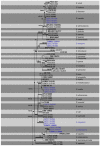



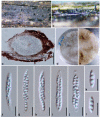

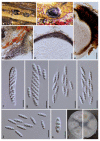
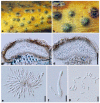
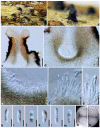
References
-
- Hyde K.D., Nilsson R.H., Alias S.A., Ariyawansa H.A., Blair J.E. One stop shop, backbone trees for important phytopathogenic genera, I. Fungal Divers. 2014;67:21–125. doi: 10.1007/s13225-014-0298-1. - DOI
-
- Maharachchikumbura S.S.N., Hyde K.D., Jones E.B.G., McKenzie E.H.C., Huang S.K. Towards a natural classification and backbone tree for Sordariomycetes. Fungal Divers. 2015;72:199–301. doi: 10.1007/s13225-015-0331-z. - DOI
-
- Maharachchikumbura S.S.N., Hyde K.D., Jones E.B.G., McKenzie E.H.C., Bhat D.J. Families of Sordariomycetes. Fungal Divers. 2016;79:1–317. doi: 10.1007/s13225-016-0369-6. - DOI
-
- Rossman A.Y., Adams G.C., Cannon P.F., Castlebury L.A., Crous P.W., Gryzenhout M., Jaklitsch W.M., Mejia L.C., Stoykov D., Udayanga D., et al. Recommendations of generic names in Diaporthales competing for protection or use. IMA Fungus. 2015;6:145–154. doi: 10.5598/imafungus.2015.06.01.09. - DOI - PMC - PubMed
Grants and funding
LinkOut - more resources
Full Text Sources

